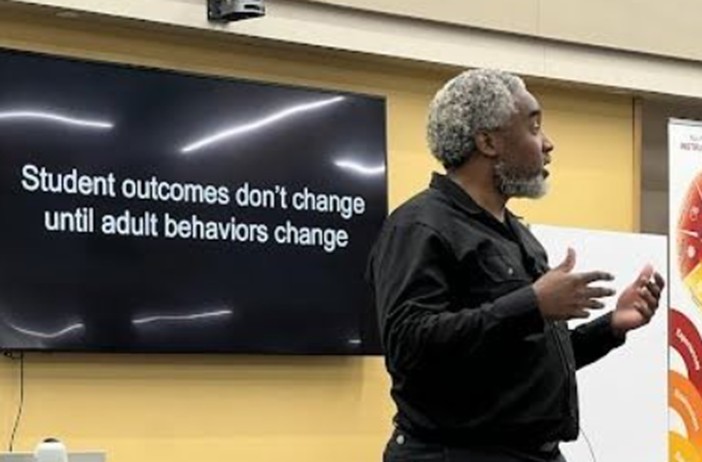AJ Crabill

Airick Journey Crabill brings a unique blend of governance expertise, strategic leadership, and a relentless commitment to equity in education. With a career spanning local school board leadership to state and national policy influence, he has consistently championed approaches that align adult decision-making with the needs of students. His work bridges research and practice, offering pragmatic solutions that empower boards, educators, and communities to create lasting academic and social outcomes for children.
About Airick Journey Crabill
Airick Journey Crabill is a nationally recognized education leader, governance expert, and passionate advocate for student success. Known as a “Student Outcomes Warrior,” Crabill’s career has been defined by the guiding principle that student outcomes don’t change until adult behaviors change. This belief not only reflects his deep understanding of the research behind effective education reform but also underscores his personal commitment to challenging himself and others to adopt practices that put students at the center of every decision.
Airick Journey Crabill currently serves as Senior Coach with Effective School Boards, where he helps state leaders and school boards transition from adult-focused agendas to student-focused governance. In his role as Director of Governance for the Council of the Great City Schools, he oversees national programming for urban education leaders and directs the certification of governance coaches grounded in the Student Outcomes Focused Governance framework. Additionally, through his work as Senior Coach of Student Led Restorative Practices, he supports students, faculty, and district leaders in reimagining discipline and curriculum to foster restorative, student-centered learning environments.
AJ Crabill has held influential leadership positions including Conservator of DeSoto ISD, where he guided the district through significant academic, governance, and financial remediation, and Deputy Commissioner at the Texas Education Agency, where he advised state leadership on charters, innovation, governance, and accountability. Earlier in his career, he chaired the Kansas City Public Schools Board, steering the district through reforms that doubled literacy and numeracy rates, raised graduation rates, and returned the district to full accreditation after decades of instability.
Beyond his leadership roles, AJ Crabill is also a prolific author and speaker. His publications include Great On Their Behalf and Our Tools They Deserve, along with contributions to governance frameworks and technical manuals widely used across the country. He has delivered keynote addresses at national and international conferences, consistently emphasizing the transformative power of governance and adult accountability in shaping brighter futures for students.
Airick Journey Crabill Highlights the Importance of Aligning Leadership with Student Needs
In the world of education, it is easy to assume that the work of a school board or district leadership team exists at a distant level, detached from the day-to-day realities inside classrooms. Meetings are filled with policies, budgets, accountability metrics, and governance frameworks that, at first glance, appear far removed from the learning experiences of students. Yet the truth is that decisions made in boardrooms have a direct and lasting impact on what happens in classrooms. The extent to which leadership aligns its vision and governance practices with the real needs of students often determines whether schools thrive or struggle.
This alignment, between leadership at the top and instruction at the ground level, is not accidental. Airick Journey Crabill emphasizes that it requires intentional effort, clarity of purpose, and a deep commitment to ensuring that every decision, from policy adoption to budget allocation, is ultimately about improving student outcomes.

Leadership as the Starting Point for Change
Educational reform often begins with a vision: a commitment to literacy growth, improved graduation rates, or greater equity across schools. But vision alone cannot transform student learning. Boards and district leaders must not only articulate goals but also design governance systems that create coherence between those goals and daily instructional practice.
When school boards focus on operational details or adult-centered concerns, such as contract negotiations or procedural debates, they risk losing sight of why governance exists in the first place: to serve students. AJ Crabill explains that by contrast, when leaders elevate student outcomes as the central purpose of their work, it establishes a culture of accountability that reverberates down to classrooms. Teachers feel supported, principals have clarity on priorities, and students benefit from focused instructional strategies.
Policy Decisions Shape Learning Conditions
One of the most direct ways leadership affects classrooms is through policy. Consider discipline practices. If a board adopts policies that emphasize exclusionary measures like suspension and expulsion, classrooms often become revolving doors, with instructional time lost and student trust eroded. Alternatively, policies that encourage restorative practices help foster environments where students remain engaged in learning, build stronger relationships, and take responsibility for their behavior.
Another example lies in curriculum adoption. A board’s decision to implement a rigorous, evidence-based literacy program can dramatically influence whether students leave third grade reading on grade level, a key predictor of lifelong success. Without leadership support for such initiatives, teachers may be left without the resources or consistency needed to help students thrive.
Even financial decisions are deeply consequential. Budget allocations determine the availability of classroom technology, the size of teacher caseloads, and the quality of professional development. When leaders prioritize resources based on student needs rather than political pressures, they make it possible for classrooms to become environments where learning can flourish.
Coherence Creates Consistency
Perhaps the most critical factor in aligning boardroom decisions with classroom realities is coherence. Coherence means that goals, strategies, and practices across the system are not competing or contradictory but working together in pursuit of student success.
For example, if a district’s strategic vision emphasizes college readiness, but its resource allocations do not provide for advanced coursework or student counseling, the vision remains an empty promise. Conversely, when leadership establishes a clear, measurable priority, such as improving third-grade reading proficiency, and then aligns training, funding, and accountability around that goal, classrooms receive consistent support. Teachers know what matters most, students receive targeted instruction, and progress can be monitored at every level.
Coherence also prevents burnout and confusion among educators. Teachers often report feeling pulled in multiple directions by shifting initiatives. Airick Journey Crabill understands that when leadership resists the temptation to chase every new trend and instead focuses on sustained, evidence-based priorities, teachers gain confidence in the system and are better able to deliver meaningful instruction.
The Human Element: Leadership Behaviors Matter
Research and experience show that systems improve only when the adults within them change their behaviors. This principle applies just as much to leaders as to teachers. If board members model accountability, transparency, and a commitment to student outcomes, that culture spreads throughout the organization.
For instance, when leaders regularly review disaggregated student performance data and use it to inform decisions, they signal that every student’s progress matters. When they engage in honest self-reflection about whether their policies are working, they demonstrate the humility necessary to improve. Such behaviors set the tone for principals and teachers, who then mirror the same commitment in their schools and classrooms.
Equally important is the relationship between leadership and the community. Engaging families, listening to students, and inviting teacher feedback ensures that decision-making is grounded in reality. This feedback loop helps leaders avoid policies that look good on paper but fail in practice.
From Vision to Impact
The ultimate test of leadership alignment is whether student outcomes improve. Rising graduation rates, narrowing achievement gaps, and increased literacy levels are tangible evidence that coherence between governance and instruction is working. On the other hand, AJ Crabill explains that stagnant outcomes often reveal a disconnect between lofty goals and the daily experiences of students.
The boardroom-to-classroom connection must be seen as a continuum. Vision without implementation leads to frustration. Implementation without vision leads to fragmentation. But when vision and execution are aligned, when leadership decisions are designed with students in mind and carried out with fidelity, the result is meaningful progress.
Centering Students in Every Decision
Education systems are complex, but their purpose is simple: to help children learn and grow. Every decision made by school boards and district leaders either strengthens or weakens that purpose. The key is coherence, aligning governance with instruction so that teachers and students experience consistency, clarity, and support.
Airick Journey Crabill emphasizes that when leaders understand that their choices ripple into classrooms, they move beyond compliance and into transformation. Policies become more than words; they become the framework that enables effective teaching. Budgets become more than numbers; they become investments in student potential. And governance becomes more than procedure; it becomes a powerful tool for shaping brighter futures.
From the boardroom to the classroom, alignment matters. And when leadership truly places student needs at the center, the entire system shifts toward outcomes that reflect what every child deserves: the opportunity to succeed.